Field Studies: Painting En Plein Air
Gaye Adams (SFCA, PSC, MPAC) is an oil painter who loves painting out on location en plein air. Her field studies are important to her because they become accurate colour references for future paintings, as well as being amazing practice for painting quickly in unpredictable situations.
She uses the experience of the day to further evolve herself as an artist and believes the best way to grow as a painter is to paint outdoors. Getting out of the studio and into a beautiful location doesn’t hurt either.
Watch our latest video, Field Studies: Painting En Plein Air and join Gaye as she takes you out on location, sharing her approach to preparing for painting in the great outdoors!
Interested in some of the materials Gaye uses?
Gamblin Artist’s Oil Colours
Gamblin Gamsol
Holbein Tin Brush Washer
M. Graham Walnut Oil
Pochade Easel
Princeton 6600 Brushes
Winsor & Newton Oil Brushes
Phoenix Canvas Panel
Opus Viewcatcher
Painter wipes
Multi-Purpose Gloves
Opus Plastic Brush Holder Tube
Scouting a Location
What do you enjoy about painting en plein air?
I enjoy painting en plein air — primarily for the thrill of the chase. Also not being stuck in the studio all the time is very appealing to me, especially in nice weather. I get to go to some beautiful places. It (painting outdoors) is difficult to do — I feel doing it regularly makes me a much better painter.
Every painter I’ve worked with wants to improve his or her skills, and painting from life is a great way to do that. I can think of nothing more challenging than painting on location. When I get back to the comfort and convenience of my studio, the painting process seems relatively easy by comparison.
What do you look for in a location? How do you choose a your subject matter and composition?
Often I will scout out a location before the actual painting day, so I don’t have to waste valuable painting time deciding where to paint. I like to consider things like: is this a safe spot? Am I away from a busy road or path? Am I on private property? If so, I need permission to set up from the land owner.
I suggest setting up where it’s shaded, and protected from wind and rain. Having an umbrella on hand will help if you cannot set up where there is shelter. Are there strong design elements within my chosen subject matter? I look for things like strong verticals and interesting shapes to help determine my composition. All of these factors will influence how your painting session plays out, so having them figured out beforehand will make for a much better painting experience.

Setting up
How do you set up your work space when you’re working outdoors? What materials and tools do you use on location?
When I return to the location to paint, I ensure that I have my Pochade Easel weighted down, and that my roll of towels is attached with bungee cords so they won’t blow away. I also carry a spare bag that can be attached to my tripod for garbage. I will take a photo before I begin the session just in case it rains or I have to leave the location before I am finished.

I wear Painting Gloves because whenever the gloves are on I know not to touch my hair, my face, and my clothes. The most important part of their function is to protect my skin from the solvent and pigments. The gloves I wear have impermeable nitrile palms to help further protect my skin. I also carry a bunch of Baby Wipes because they are great for cleaning up.
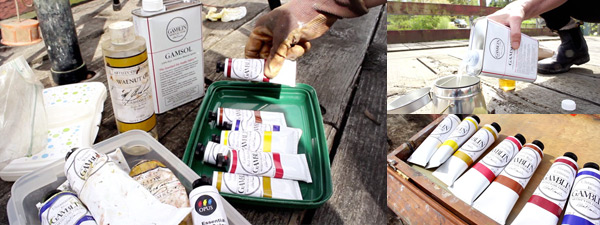
I prefer to line up my palette with colours from warm to cool, light to dark. I squeeze them out in a long stripe so that I don’t pollute the paint that is already on my palette. I like using the Gamblin Oil Colours because I find they are a very high quality and that they don’t dry up too quickly.
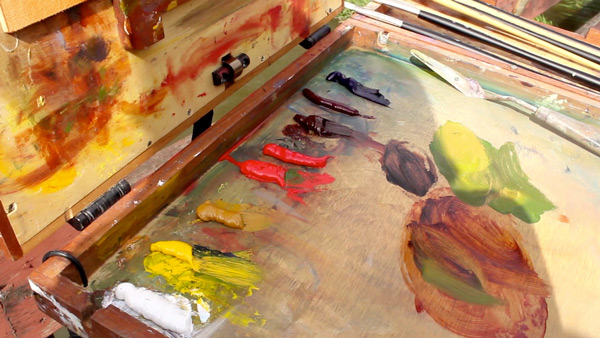
I also use Gamblin Gamsol solvent in a Holbein Tin Brush Washer. I like using Gamsol because it has hardly any detectible odour and it does not evaporate into the air much, meaning you are not breathing it in. You can also recycle your Gamsol for future use by pouring the used solvent into another jar and letting it settle for a few days. Once it’s settled, take a paper towel and wipe off the residue that has settled on top to reveal the clean solvent. I paint almost every day, keeping two jars in rotation, and if I recycle it a gallon of Gamsol will last me about a year.

I use M. Graham Walnut Oil as my medium, mixed with a bit of Gamsol. If the paint is a bit too thick and sticky, I’ll use it to help thin the colours when I need them to spread more readily. This is especially useful in really warm or really cold weather.
I am using mostly Princeton 6600 Brushes and Winsor & Newton Oil Brushes because they keep their shape. If a brush doesn’t keep its shape the paint never lays where you put it and it can be very frustrating.
I prefer a Canvas Panel with a bit of tooth because it makes it easier to drag the paint and create soft edges. Sometimes to help render edges and to achieve certain textures I will scrape paint away with the handle tip of the brush — whatever it takes.
The Painting Process
What do you find is the best way to get started with a field study?
I begin applying an underpainting of Transparent Earth Red. I like the underpainting because it will get rid of the stark white of the canvas that can be a bit blinding. The white also makes it harder to judge accurate colour values, particularly if the sun is shining right on your canvas.
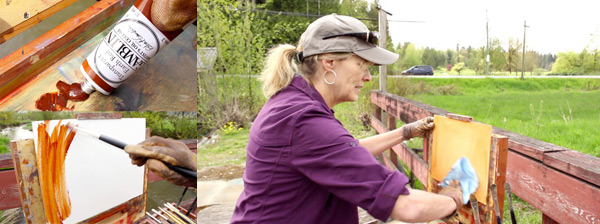
The other reason I prefer an underpainting of Transparent Earth Red is because so much of the landscape is green that it helps temper it down a bit. Also, this red is a warm colour and if it peeks through it has a more pleasing effect. Always better to have a bit of red peeking through opposed to having little dots of white show up. Once I’ve covered the canvas with Transparent Earth Red, I give it a wipe with a shop towel to thin it out and help it dry quicker.
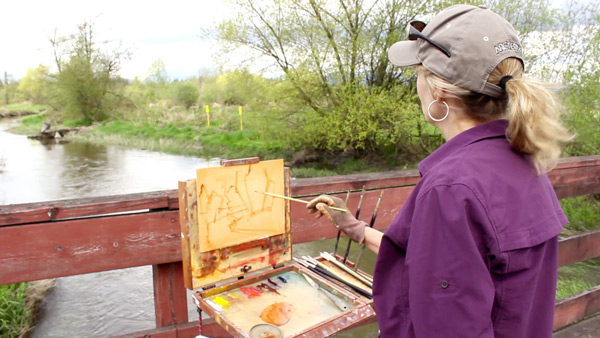
Now I begin by adding a few gesture lines to indicate where the major masses will lie within the design. The major masses in this painting are the large shapes: the mass of the mountains, the mass of the foreground trees, the fields and the water — just the big shapes to start with. Big shapes to small shapes.

I’m establishing the major masses with a larger brush, and I will then begin blocking in darker areas working with thin layers to establish the composition using tonal values. I work very directly, keeping the paint quite thin as I move into colour. Try to keep your colour values as accurate as possible so that you don’t have to paint things twice.
How do you compensate for changing light and still achieve accurate colour?
If you have set up in the shade, it will help with that as it is sheltering your canvas from the changing sunlight. I compensate for changing light by painting those things which are going to change right at the beginning. Paying close attention to all the colour and tonal relationships is really key in this. Is it lighter, darker, warmer, cooler, more neutral, more intense — paying attention to all those relationships — it’s all about relationships.
I try not to spend any longer than an hour and a half on a field study. The light changes substantially over the course of an hour and a half, and I will end up chasing the light if I take much longer than that.
What is your favourite or most helpful tool for painting on location?
One tool that I often use in the field is a Viewcatcher, and really I use it more as a colour isolator. You shut one eye, hold it up and look at that dot of colour and value against the grey of the view finder.Then you move the viewfinder in front of your painting and see how they compare. I call it the “Peek-hole of Truth” and it works like a hot dang.
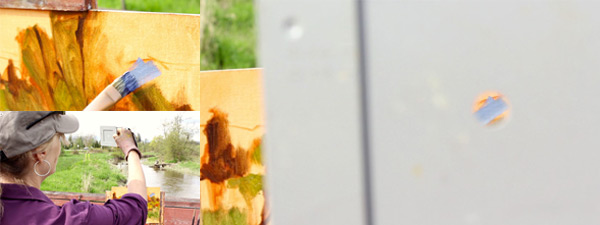
How do you compensate for oils slow drying time?
Most of us who are oil painters like oil paints for their slow-drying time because it means that they’re malleable the entire time we’re working. It can be an advantage or a disadvantage depending on how you work, but if you like to work wet-in-wet, it’s the best thing ever.
You always have to control the amount of moisture on your brush, so when you’re cleaning a brush, wipe the paint off with a rag, swizzle it around in your Gamsol, and then dry it before you put it back into your paint. Otherwise you’ll create a slicky, slimy mess.
What are some of the challenges you’ve faced with today’s painting session?
The biggest challenge in this piece is the greens — there is so much green, so just about every green I’m mixing has a bit of red in it. I’m not using a tube of green because I want all my greens to be different. I find if I mix from a palette that contains primaries and no secondaries I get a better result.
The edges on the tree in the foreground are very lacy, so I have to be very careful to keep the edges soft and broken. Otherwise it’s not going to read at all.

How can a study be more useful than a photograph?
The main reason I do plein air studies is because I want to record accurately the colours and values I see on location. When you take a photo reference the camera can blow out all the whites, underexpose all of the darks, or can change the colour temperature. When you download from a digital camera your computer monitor makes another decision about the colours, soI prefer to use my naked eye. It’s more accurate.
How does your painting method change as you progress through the painting?
I refine the shapes as I work, adjusting value and colours as I go along. The thickest paint and the very lightest values will go on last. I will also adjust my edges towards the end of the painting.

How do you decide when your field study is finished?
Once you find all of the colour relationships are correct, the value relationships are correct, the composition is working, then it’s time to stop before you ruin it with too much detail.
Packing Up
What is your procedure for packing up after an outdoor painting session?
Everything I pack in I will pack out. I put my wet brushes into a piece of PVC tubing that has a lid attached to it. You won’t be able to wash the brushes out properly until you get them back to the studio, so this is airtight and rigid to keep them safe while in my backpack. The Holbein container is leakproof and durable, so I take my Gamsol back to the studio in it and dump the solvent out into a jar to let it settle out before I reuse it.
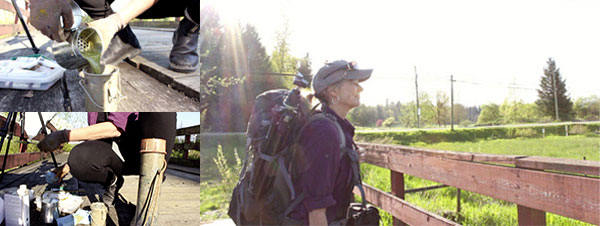
My wet painting will fit into the lid of my pochade box, which is really convenient, and if you don’t have a pochade box that has a panel carrier, there are lots of really lightweight, very efficient, and inexpensive panel carriers that can be purchased or built.
Tip: Many plein air artists get creative and build their own tools to meet specific needs on location. Trying them first is essential in figuring out what works and what needs adjustments. There are many websites with instructions to make your own wet canvas or panel carrier. Here are a couple we like: Wayne Gaudon’s 2-Frame Canvas Carrier Instructions and Marc Hanson’s Canvas Carrier Instructions
Back in the Studio
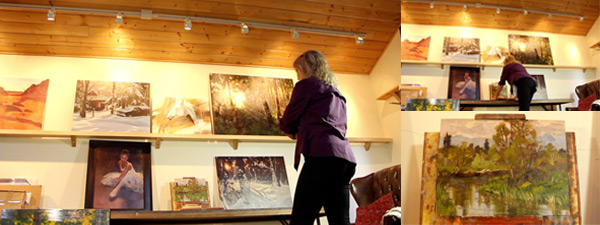 What is your goal for creating a study? Do you work from these studies, or are they finished pieces?
What is your goal for creating a study? Do you work from these studies, or are they finished pieces?
The main thing that I come away with if I am successful that day, is an accurate record of the sense of the place, and the value and colour relationships. My plein air studies serve as a practice and as a record of the day. I will turn some into larger pieces, but some just stand on their own. •
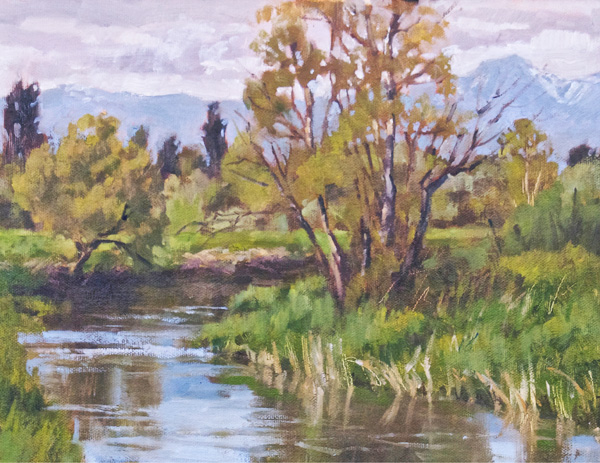
This summer, Gaye has begun her own en plein air challenge called the The 91 Days of Summer Project. Everyday she will go out on location and create a new painting and discuss the challenges and successes she had during the painting session. Keep up to date with her 91 paintings by visiting her blog, gayeadams.blogspot.ca and visit her online at www.gayeadams.com.
